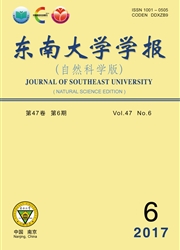

 中文摘要:
中文摘要:
针对板块平衡法缺乏足尺试验验证的缺点,选取2块4.6m×2.7m钢筋混凝土矩形板和2块2.7m×2.7m钢筋混凝土方形板,进行了模拟均布荷载作用下的大挠度加载试验.试验结果表明:在形成塑性铰线时,板块平衡法中的挠度特征值计算公式对矩形板有效,对方形板则较为保守;板块平衡法中原有的最大挠度特征值计算公式对混凝土双向板较为保守.为此,对形成塑性铰线时的挠度特征值计算公式进行了修正,并提出了新的最大挠度特征值计算公式.将其应用于板块平衡法中,根据已有的混凝土板试验数据,对混凝土板的极限承载力进行了理论和试验的对比分析.结果表明,修正的板块平衡法可以准确地计算大变形下考虑受拉薄膜效应影响的极限承载力.
 英文摘要:
英文摘要:
To overcome the shortcoming that the segment equilibrium method cannot be validated by adequate large-scale tests, two 4.6 m×2.7 m rectangular slabs and two 2.7 m×2.7 m square slabs are tested under the simulated uniform distributed load with large deflection. Test results show that the formula of deflection characteristic value is effective for the rectangular slabs while conservative for the square slabs when plastic hinge lines are formed. However, the original formula to define the maximum deflection of slabs is conservative for both the rectangular slabs and the square slabs. To solve the above problems, the formulae of the deflection characteristic value corresponding to the formulation of plastic hinge lines and the occurrence of maximum deflection are modified. According to the published experimental data of concrete slabs, the limit load-carrying capacities of these tested slabs are calculated through the segment equilibrium method adopting the modified formula of deflec- tion characteristic value. By comparing with the test data, it is indicated that the modified segment equilibrium method can accurately calculate the limit load-carrying capacities by incorporating tensile membrane action.
 同期刊论文项目
同期刊论文项目
 同项目期刊论文
同项目期刊论文
 Fire behaviour of continuous reinforced concrete slabs in a full-scale multi-storey steel-framed bui
Fire behaviour of continuous reinforced concrete slabs in a full-scale multi-storey steel-framed bui 期刊信息
期刊信息
